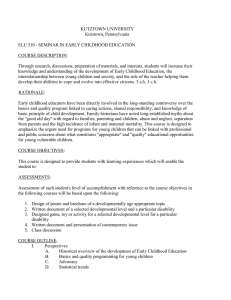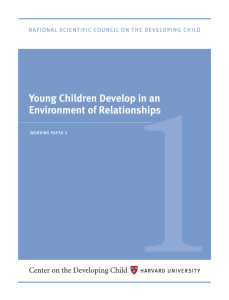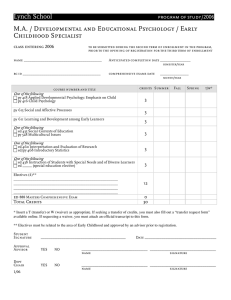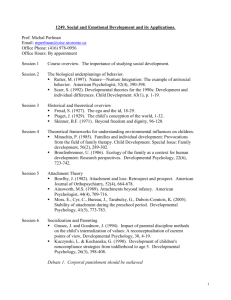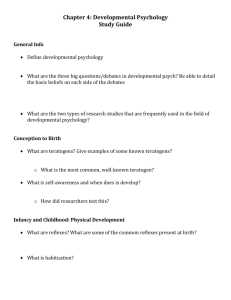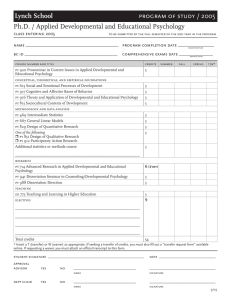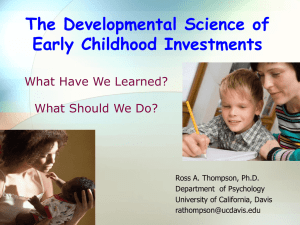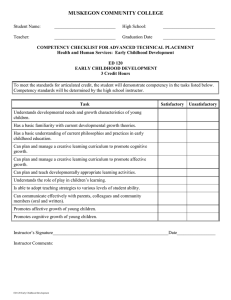1 Young children Develop in an environment of relationships working paper
advertisement
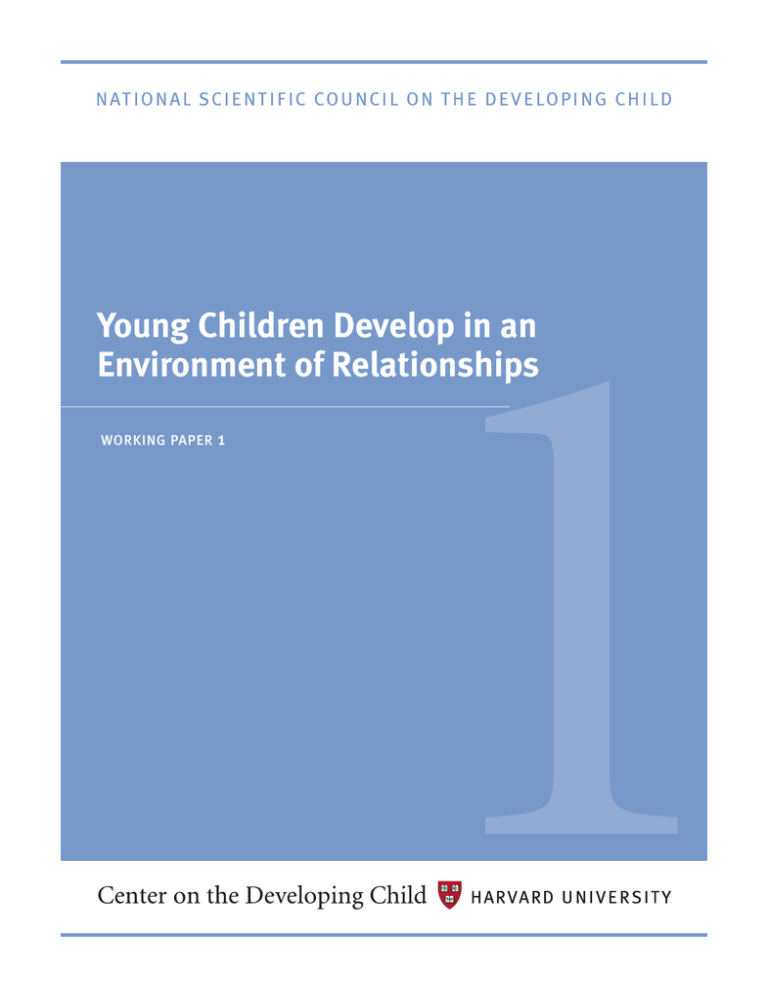
1 Young Children Develop in an Environment of Relationships working paper 1 members Jack P. Shonkoff, M.D., Chair Julius B. Richmond FAMRI Professor of Child Health and Development; Director, Center on the Developing Child, Harvard University W. Thomas Boyce, M.D. Sunny Hill Health Centre/BC Leadership Chair in Child Development; Professor, Graduate Studies and Medicine, University of British Columbia, Vancouver Judy Cameron, Ph.D. Professor of Psychiatry, University of Pittsburgh; Senior Scientist, Oregon National Primate Research Center; Professor of Behavioral Neuroscience and Obstetrics & Gynecology, Oregon Health and Science University Greg J. Duncan, Ph.D. Distinguished Professor, Department of Education, University of California, Irvine Nathan A. Fox, Ph.D. Distinguished Professor; Director, Child Development Laboratory, University of Maryland College Park Megan R. Gunnar, Ph.D. Regents Professor and Distinguished McKnight University Professor, Institute of Child Development, University of Minnesota Pat Levitt, Ph.D. Director, Zilkha Neurogenetic Institute; Provost Professor of Neuroscience, Psychiatry and Pharmacy Chair, Department of Cell and Neurobiology, Keck School of Medicine of the University of Southern California Linda C. Mayes, Ph.D. Arnold Gesell Professor of Child Psychiatry, Pediatrics, and Psychology, Yale Child Study Center Special Advisor to the Dean, Yale School of Medicine Ross A. Thompson, Ph.D. Professor of Psychology, University of California, Davis contributing members Susan Nall Bales President, FrameWorks Institute William T. Greenough, Ph.D. Swanlund Professor of Psychology, Psychiatry, and Cell and Developmental Biology; Director, Center for Ad­vanced Study at University of Illinois, Urbana-Champaign Eric Knudsen, Ph.D. Edward C. and Amy H. Sewall Professor of Neurobiology, Stanford University School of Medicine Deborah Phillips, Ph.D. Professor of Psychology and Associated Faculty, Public Policy Institute; Co-Director, Research Center on Children in the U.S., Georgetown University Arthur J. Rolnick, Ph.D. Senior Vice President and Director of Research, Federal Reserve Bank of Minneapolis FORMER members Betsy Lozoff, M.D. Professor of Pediatrics, University of Michigan Medical School; Research Professor. Center for Human Growth and Development, University of Michigan partners The FrameWorks Institute The National Governors Association Center for Best Practices The National Conference of State Legislatures Bruce S. McEwen, Ph.D. Alfred E. Mirsky Professor; Head, Harold and Margaret Milliken Hatch Laboratory of Neuroendocrinology, The Rockefeller University sponsors Charles A. Nelson, Ph.D. Richard David Scott Chair in Pediatric Developmental Medicine Research, Children’s Hospital Boston; Professor of Pediatrics and Neuroscience, Harvard Medical School The Norlien Foundation The Birth to Five Policy Alliance The Buffett Early Childhood Fund The John D. and Catherine T. MacArthur Foundation The Pierre and Pamela Omidyar Fund About the Authors The National Scientific Council on the Developing Child, housed at the Center on the Developing Child at Harvard University, is a multidisciplinary collaboration designed to bring the science of early childhood and early brain development to bear on public decisionmaking. Established in 2003, the Council is committed to synthesizing and communicating science to help inform policies that promote successful learning, adapative behavior, and sound physical and mental health for all young children. For more information, go to http://www.developingchild.net. Please note: The content of this paper is the sole responsibility of the authors and does not necessarily represent the opinions of the funders or partners. Suggested citation: National Scientific Council on the Developing Child. (2004). Young children develop in an environment of relationships. Working Paper No. 1. Retrieved from http://www.developingchild.net © 2004, National Scientific Council on the Developing Child, Center on the Developing Child at Harvard University UPDATED & REPRINTED: OCTOBER 2009 The Issue healthy development depends on the quality and reliability of a young child’s relationships with the important people in his or her life, both within and outside the family. Even the development of a child’s brain architecture depends on the establishment of these relationships.1, 2, 3, 4, 5, 6 Growth-promoting relationships are based on the child’s continuous give-and-take (“serve and return” interaction) with a human partner who provides what nothing else in the world can offer – experiences that are individualized to the child’s unique personality style; that build on his or her own interests, capabilities, and initiative; that shape the child’s self-awareness; and that stimulate the growth of his or her heart and mind. Young children experience their world as an environment of relationships, and these relationships affect virtually all aspects of their development – intellectual, social, emotional, physical, behavioral, and moral. The quality and stability of a child’s human relationships in the early years lay the foundation for a wide range of later developmental outcomes that really matter – self-confidence and sound mental health, motivation to learn, achievement in school and later in life, the ability to control aggressive impulses and resolve conflicts in nonviolent ways, knowing the difference between right and wrong, having the capacity to develop and sustain casual friendships and intimate relationships, and ultimately to be a successful parent oneself. Stated simply, relationships are the “active ingredients” of the environment’s influence on healthy human development. They incorporate the qualities that best promote competence and well-being – individualized responsiveness, mutual action-and-interaction, and an emotional connection to another human being, be it a parent, peer, grandpar- Young children experience their world as an environment of relationships, and these relationships affect virtually all aspects of their development. ent, aunt, uncle, neighbor, teacher, coach, or any other person who has an important impact on the child’s early development. Relationships engage children in the human community in ways that help them define who they are, what they can become, and how and why they are important to other people. 7, 8, 9, 10, 11, 12, 13 In the words of the distinguished developmental psychologist Urie Bronfenbrenner: … in order to develop normally, a child requires progressively more complex joint activity with one or more adults who have an irrational emotional relationship with the child. Somebody’s got to be crazy about that kid. That’s number one. First, last, and always. What Science Tells Us nurturing and stable relationships with caring adults are essential to healthy human development beginning from birth. Early, secure attachments contribute to the growth of a broad range of competencies, including a love of learning, a comfortable sense of oneself, positive social skills, multiple successful www.developingchild.NET relationships at later ages, and a sophisticated understanding of emotions, commitment, morality, and other aspects of human relationships. Stated simply, establishing successful relationships with adults and other children provides a foundation of capacities that children will use for a lifetime.14, 15, 16, 17 Young Children Develop in an Environment of Relationships 1 National scientific council on the developing child The “serve and return” interaction between parent and baby – in which young children naturally reach out for interaction through babbling, facial expressions, and gestures and adults respond with the same kind of vocalizing and gesturing back at them – builds and strengthens brain architecture and creates a relationship in which the baby’s experiences are affirmed and new abilities are nurtured. Children who have healthy relationships with their primary caregivers are more likely to develop insights into other people’s feelings, needs, and thoughts, which form Children who develop warm, positive relationships with their kindergarten teachers are more excited about learning, more positive about coming to school, more self-confident, and achieve more in the classroom. a foundation for cooperative interactions with others and an emerging conscience. Sensitive and responsive parent-child relationships also are associated with stronger cognitive skills in young children and enhanced social competence and work skills later in school, which illustrates the connection between social/emotional development and intellectual growth. The broader quality of the home environment (including toys, activities, and interactions within the family setting) also is strongly related to early cognitive and language development, performance on IQ testing, and later achievement in school.12, 18, 19, 20, 21, 22, 23, 24, 25, 26 Young children also learn a great deal from each other. They learn how to share, to engage in reciprocal interactions (e.g., taking turns, giving and receiving), to take the needs and desires of others into account, and to manage their own impulses. Just being around other children, how- ever, is not enough. The development of friendships is essential, as children learn and play more competently in the rapport created with friends rather than when they are dealing with the social challenges of interacting with casual acquaintances or unfamiliar peers.27, 28 The warmth and support of the caregiver in a 2 Young Children Develop in an Environment of Relationships child care setting also influence the development of important capabilities in children, including greater social competence, fewer behavior problems, and enhanced thinking and reasoning skills at school age. Young children benefit in these ways because of the secure relationships they develop in such settings, and because of the ways in which the caregivers provide cognitively stimulating activities and support for developing positive relationships with other children. Unfortunately, the generally poor quality of care provided in many child care arrangements in the United States does not support these benefits because of high caregiver turnover, poorly designed programs, or inadequate preparation of staff. Current research also suggests the additional risk that a greater amount of time in outof-home care during infancy may be associated with greater disobedience and aggression by the time children enter school.12, 22, 23, 29, 30, 31, 32, 33 Relationships are important to school adjustment. Children who develop warm, positive relationships with their kindergarten teachers are more excited about learning, more positive about coming to school, more selfconfident, and achieve more in the classroom. Relationships with peers also are important. Children who experience greater peer acceptance and friendship tend to feel more positively about the school experience and perform better in the classroom.33, 34, 35, 36, 37, 38 Children have different ways of interacting with their peers. Some are gregarious, others are too shy to get involved (although they want to), some need time to “warm up,” and others are not as interested in being sociable. All of these variations fall within a normal range, and it is essential to differentiate among the many potential reasons (both biological and environmental) that a young child may have limited or difficult interactions with others. Playing cooperatively, making friends, and sustaining friendships over time are not always easy. Any child with severely limited peer involvement is at considerable risk for significant adverse developmental consequences.39, 40, 41, 42, 43 Secure and stable relationships with caring adults assure that young children are adequately nourished; protected from dangerous illnesses, exposure to toxins, and hazards that www.developingchild.NET what science tells us can lead to preventable injuries; provided preventive health check-ups; protected from excessive stress; and afforded predictable daily routines that convey a sense of security. These influences contribute significantly to healthy brain development and depend upon the care and support provided by individuals in the community as well as in the family.12, 44 Young children are highly vulnerable emotionally to the adverse influences of parental mental health problems and family violence. One of the most extensively documented of these vulnerabilities is the negative impact of a mother’s clinical depression on her young children’s emotional development, social sensitivity, and concept of themselves, effects that have been demonstrated in both developmental research and studies of brain functioning. Young children who grow up in seriously troubled families, especially those who are vulnerable temperamentally, are prone to the development of behavioral disorders and conduct problems.45, 46, 47, 48, 49 Animal studies have shown that the quality of the mother-infant relationship can influence gene expression in areas of the brain that regulate social and emotional function and can even lead to changes in brain structure. The nature of the relationship also can have long-term influences (into adulthood) on how the body copes with stress, both physically and emotionally.15, 50, 51, 52, 53, 54, 55, 56, 57, 58, 59, 60 Science indicates that the quality of early parent-child relationships can be strengthened, but successful interventions are more difficult to achieve when relationships are significantly troubled or disturbed. Preventive interventions also can produce a variety of positive outcomes, depending on the extent to which the knowledge and skills of the staff and the quality of the implementation are matched to the magnitude of the challenges being addressed. 12, 61, 62, 63, 64, 65 Popular Misrepresentations of Science as the public’s appetite for scientific information about the development of young children is whetted by exciting new findings, the risk of exaggerated or misleading messages grows. Within this context, it is essential that scientific fact be differentiated from popularly accepted fiction. Contrary to common assumptions, scientific evidence shows that the influence of relationships on development continues throughout the lifespan. These relationships are not more important at a particular stage of a child’s life compared to another, but the nature of those impacts does vary by age and developmental status.4 In contrast to frequently cited concerns, science indicates that young children can benefit significantly from secure relationships with multiple caregivers (within or outside the family), while their attachments to their parents remain primary and central.13 There is no credible sci- relationships with other nurturing and reliable adults who they trust, especially early in life, interfere with the strength of the young child’s primary relationship with his or her parents. Although young children certainly can establish healthy relationships with more than one or two adults, prolonged separations from familiar caregivers and repeated “detaching” and “re-attaching” to people who matter are emotionally distressing and can lead to enduring problems. There is no scientific evidence to sup- port the belief that frequently rotating relationships with large numbers of adult caregivers provide valuable learning opportunities in the early years of life. Although the importance of sustained, reliable relationships within the family is well understood, the need for stable and predictable relationships in child care settings is acknowledged less frequently, and the disruptive impacts of the abrupt changes related to high caregiver turnover are too often disregarded.66, 67 entific evidence to support the claim that close www.developingchild.NET Young Children Develop in an Environment of Relationships 3 National scientific council on the developing child The Science-Policy Gap the importance of mother-child relationships is old news. The importance of other family relationships (with fathers, siblings, and grandparents) is semi-old news. The impact of these relationships on the development of the brain is new news. And the important influence of relationships outside of the family – with child care providers, peers, teachers, neighbors, and other adults and children in the community – is even newer, because these individuals are often valued more for what they do than for the meaning of their role in the life experience of very young children. Greater understanding of what science tells us about the importance of a range of relationships for early childhood development leads us to think about many areas of policy and practice in a new light. “Quality” in early child care and education, for example, is often defined in terms of adultchild ratios, group size, physical facilities, and, more recently, cognitively oriented curriculum. But “quality” is perceived differently when we view child care as a prominent feature of the environment of relationships in which young children develop. The importance of ensuring that relationships in child care are nurtur- problematic when viewed in relation to extensive scientific evidence of the vital importance of establishing a strong and healthy mother-infant bond beginning in the early months of life. They elicit even greater alarm when viewed in the context of concerns about the potential adverse effects on very young babies of early and extended experiences in out-of-home child care arrangements of highly variable quality.71, 72, 73 For mothers receiving welfare support under Temporary Assistance to Needy Families (TANF), federal rules require that states impose work requirements of 30 or more hours per week. Although modifications are permissible, about half of the states do not exempt mothers of children less than 12 months of age, and some states permit mandated maternal employment beginning a few weeks after a baby’s birth. When viewed as an adult-oriented employment policy, TANF can be a subject for reasonable debate. But when examined from a child-oriented perspective, it reflects a wide gap between what we know about the importance of early family relationships and what we are doing to promote the health and well-being of our nation’s most vulnerable young children.74, 75 Parental leave policies in the United States currently provide parents of young children with few options. ing, stimulating, and reliable leads to an emphasis on the skills and personal attributes of the caregivers, and on improving the wages and benefits that affect staff turnover.12, 68, 69, 70 Parental leave policies in the United States currently provide parents of young children with few options. A maximum of only three months of unpaid leave is assured for parents of newborns, and these policies cover only about half of American workers. Of those who are eligible for leave, only those who can get by without earned income can afford to take it, and fewer than half of workers even have this option without risking loss of their jobs. These policies seem highly 4 Young Children Develop in an Environment of Relationships www.developingchild.NET Implications for policy and programs Implications for Policy and Programs the science of early childhood development is sufficiently mature to support a number of well-documented, evidence-based implications for those who develop and implement policies that affect the health and well-being of young children. Five compelling messages are particularly worthy of thoughtful consideration: When considered within the context of a child’s environment of relationships, the concept of school readiness is not exclusively a matter of fostering literacy and number skills. It must also include the capacity to form and sustain positive relationships with teachers, children, and other adults, and develop the social and emotional skills for cooperating with others.66, 76, 77 When viewed as an important part of a child’s environment of relationships, early childhood education must strive to involve young children in reciprocal learning interactions with teachers and peers rather than isolated “pre-academic” work, and it should capitalize on children’s natural interests and intrinsic drive to learn, rather than follow an adult-determined agenda. Stated sim- ply, young children learn best in an interactive, relational mode rather than through an education model that focuses on rote instruction.78 Extending the length and coverage of leave currently provided under the Family and Medical Leave Act would provide the critical necessities of time and economic security that are required for parents to develop the nurturing relationships with their children that are essential to healthy development. Much can be learned from other industrialized nations that promote greater parental choice and child well-being by providing subsidized parental leave for those who wish to stay at home with their babies, and affordable, decent quality, early care and education for the children of those who choose or are compelled to return to work.73, 78 In the absence of consistent evidence that maternal employment intrinsically helps or hurts most children, science has little to add to the ongoing political debate about whether paid work should be a mandated requirement for mothers on public assistance. Nevertheless, emerging data that www.developingchild.nET suggest that maternal employment in the first six months of an infant’s life may be associated with later developmental problems, and concerns about the potential adverse impacts of extended out-of-home child care experiences on young children’s social development and Stated simply, young children learn best in an interactive, relational mode rather than through an education model that focuses on rote instruction. behavior, require thoughtful public discussion. Each raises serious concerns about the potential harm of mandated maternal employment and the limited availability of affordable, high quality child care, particularly for the already vulnerable babies of low-income women on public assistance. It is time for society to weigh the evidence carefully and fashion a more thoughtful policy for parents in the workforce, particularly for those who earn low wages.12, 79, 80 Traditional child welfare approaches to maltreatment focus largely on physical injury, the relative risk of recurrent harm, and questions of child custody, in conjunction with a criminal justice orientation. In contrast, when viewed through a child development lens, the abuse or neglect of young children should be evaluated and treated as a matter of child health and development within the context of a family relationship crisis, which requires sophisticated expertise in both early childhood and adult mental health. The regularized referral of suspected cases of child abuse or neglect from the child welfare system to the early intervention system would assure appropriate developmental and behavioral assessment and treatment as needed. Child abuse prevention strategies that emphasize both the developmental needs of children and the importance of community-based supports for families provide another clear example of how we can close the gap between science and practice for our most vulnerable young children.12 Young Children Develop in an Environment of Relationships 5 National scientific council on the developing child References 1. Berscheid, E., & Reis, H.T. (1998). Attraction and close relationships. In D.T. Gilbert, S.T. Fiske, & G. Lindzey (Eds.), Handbook of social psychology, Vol. 1 (2nd Ed.). New York: McGraw-Hill. 2. Collins, W.A., & Laursen, B. (1999). Relationships as developmental contexts. The Minnesota Symposia on Child Psychology, Vol. 30. Mahwah, NJ: Lawrence Erlbaum Associates. 3. Dunn, J. (1993). Young children’s close relationships: Beyond attachment. Newbury Park, CA: Sage Publications. 4. Reis, H.T., Collins,W.A. & Berscheid, E. (2000). Relationships in human behavior and development. Psychological Bulletin, 126(6), 844-872. 5. Dawson, D. , & Fischer, K.W. (Eds.) (1994). Human behavior and the developing brain. New York: Guilford Press. 6. Panksep, J. (1998). Affective neuroscience. New York: Oxford. 7. Bornstein, Marc (Ed.) (2002). Handbook of parenting (2nd ed.). Mahwah, NJ: Lawrence Erlbaum Assoc. 8. Cassidy, J. & Shaver, P.R. (Eds.) (1999). Handbook of attachment: Theory, research, and clinical applications (pp. 89-111). New York: Guilford. 9. Cochran, M., Larner, M., Riley, D., Gunnarsson, L., & Henderson, C.R., Jr. (1990). Extending families: The social networks of parents and their children. New York: Cambridge University Press. 10. Fogel, A. (1993). Developing through relationships: Origins of communication, self, and culture. Chicago: University of Chicago Press. 11. Rogoff, B. (1990). Apprenticeship in thinking: Cognitive development in social context. New York: Oxford University Press. 12. Shonkoff, J.P., & Phillips, D. (Eds.) (2000). From neurons to neighborhoods: The science of early childhood development. Committee on Integrating the Science of Early Childhood Development.Washington, DC: National Academy Press. 13. Thompson, R.A. (1998). Early sociopersonality development. In W. Damon (Ed.), & N. Eisenberg (Vol. Ed.) Handbook of child psychology, Vol. 3: Social, emotional, and personality development. (5th ed., pp. 25-104). New York: John Wiley & Sons. 14. Belsky, J., & Cassidy, J. (1994). Attachment: Theory and evidence. In M. Rutter & D. Hay (Eds.), Development through life. (pp. 373-402). Oxford, UK: Blackwell Scientific. 15. Thompson, R.A. (1999). Early attachment and later development. In J. Cassidy & P.R. Shaver (Eds.), Handbook of attachment: Theory, research, and clinical applications (pp. 265-286). New York: Guilford Press. 16. Thompson, R.A. (2000).The legacy of early attachments. Child Development, 71(1),145-152. 17. Waters, E., Kondo-Ikemura, K., Posada, G., & Richters, J.E. (1991). Learning to love: Mechanisms and milestones. In M. Gunnar & L. Sroufe (Eds.), Self processes and development. Minnesota Symposia on Child Psychology,Vol. 23. (pp. 217-255). Hillsdale NJ: Erlbaum. 18. Bradley, R.H., Caldwell, B.M. Rock, S.L., & Ramey, C.T. (1989). Home environment and cognitive development in the first three years of life: A collaborative study 6 Young Children Develop in an Environment of Relationships involving six sites and three ethnic groups in North America. Developmental Psychology, 25(18), 217-235. 19. Bradley, R.H., Caldwell, B.M., & Rock, S.L. (1988). Home environment and school performance: A ten-year followup and examination of three models of environmental action. Child Development, 59(2), 852-867. 20. Estrada, P., Arsenio,W.F., Hess, R.D., & Holloway, S.D. (1987). Affective quality of the mother-child relationship: Longitudinal consequences for children’s schoolrelevant cognitive functioning. Developmental Psychology, 23(2), 210-215. 21. Gottfried,A.W., & Gottfried,A.E. (1984). Home environment and early cognitive development. New York: Academic Press. 22. Peisner-Feinberg, E.S., Burchinal, M.R., Clifford, R.M., Culkin, M.I., Howes, C., Kagan, S.I.,Yazejian, . . . Zelazo, J. (2000). The children of the Cost, Quality, and Outcomes Study go to school: Technical report. Chapel Hill, NC: Frank Porter Graham Child Development Center, University of North Carolina at Chapel Hill. 23. Pianta, R.C., Nimetz, S.L., & Bennett, E. (1997). Motherchild relationships, teacher-child relationships, and school outcomes in preschool and kindergarten. Early Childhood Research Quarterly, 12(3), 263-280. 24. Kochanska, G., & Thompson, R.A. (1997).The emergence and development of conscience in toddlerhood and early childhood. In J.E. Grusec & L. Kuczynski (Eds.), Parenting and children’s internalization of values (pp. 53-77). New York: Wiley. 25. Thompson, R.A., Meyer, S., & McGinley, M. (2006). Understanding values in relationship: The development of conscience. In M. Killen & J. Smetana (Eds.), Handbook of moral development. Mahwah, NJ: Lawrence Erlbaum Associates. 26. Kochanska, G. (2002). Mutually responsive orientation between mothers and their young children: A context for the early development of conscience. Current Directions in Psychological Science, 11(6), 191-195. 27. Rubin, K.H., Bukowski,W., & Parker, J.G. (1998). Peer interactions, relationships, and groups. In W. Damon (Ed.) & N. Eisenberg (Vol. Ed.), Handbook of child psychology, Vol. 3: Social, emotional, and personality development (5th ed., pp. 619-700). New York: Wiley. 28. Rose-Krasnor, L. (1997).The nature of social competence: A theoretical review. Social Development, 6, 111-135. 29. Lamb, M.R. (1998). Nonparental child care: Context, quality, correlates. In W. Damon (Ed.), & I.E. Seigel & K.A. Renninger (Vol. Eds.), Handbook of child psychology, Vol. 4: Child psychology in practice. (5th ed., pp.73-134). New York: Wiley. 30. NICHD Early Child Care Research Network (2000).The relation of child care to cognitive and language development. Child Development, 71(4), 958-978. 31. NICHD Early Child Care Research Network (2002). Early child care and children’s development prior to school entry: Results from the NICHD Study of Early Child Care. American Educational Research Journal, 39(1), 133-164. 32. NICHD Early Child Care Research Network (2003). Does amount of time spent in child care predict socioemotional adjustment during the transition to kindergarten? Child Development, 74(4), 976-1005. www.developingchild.NET REFERENCEs 33. Pianta, R.C. (1999). Enhancing relationships between children and teachers. Washington, DC: American Psychological Association. 34. Birch, S., & Ladd, G. (1997).The teacher-child relationship and children’s early school adjustment. Journal of School Psychology, 35, 61-79. 35. Ladd, G.W., Birch, S.H., & Buhs, E.S. (1999). Children’s social and scholastic lives in kindergarten: Related spheres of influence? Child Development, 70(6), 1373-1400. 36. Ladd, G.W., Kochenderfer, B.J., & Coleman, C.C. (1996). Friendship quality as a predictor of young children’s early school adjustment. Child Development, 67(6), 1103-1118. 37. Ladd, G.W., Kochenderfer, B.J., & Coleman, C.C. (1997). Classroom peer acceptance, friendship, and victimization: Distinct relational systems that contribute uniquely to children’s school adjustment? Child Development, 68, 1181-1197. 38. Pianta, R.C., & Steinberg, M. (1992). Teacher-child relationships and the process of adjusting to school. In R.C. Pianta (Ed.), Beyond the parent:The role of other adults in children’s lives. New Directions for Child Development, 57, 61-80. 39. Dunn, J. (2004). Children’s friendships: The beginnings of intimacy. Oxford, UK: Blackwell Publishers. 40. Fox, N.A., Henderson, H.A., Rubin, K.H., Calkins, S.D., & Schmidt, L.A. (2001). Continuity and discontinuity of behavioral inhibition and exuberance: Psychophysiological and behavioral influences across the first four years of life. Child Development, 72 (1), 1-21. 41.Kagan, J., Reznick, J.S., & Snidman, N. (1987).The physiology and psychology of behavioral inhibition in children. Child Development, 58(6), 1459-1473. 42.Rothbart, M.K., Ahadi, S.A., & Hershey, K.L.(1994). Temperament and social behavior in childhood. MerrillPalmer Quarterly, 40(1), 21-39. 43. Rubin, K.H., Coplan, R.J., Nelson, L.J., Cheah, C.S.L., & Lagace-Seguin, D.G. (1999). Peer relationships in childhood. In M.H. Bornstein & M.E. Lamb (Eds.), Developmental psychology: An advanced textbook (4th ed., pp. 451-501). Mahwah, NJ: Lawrence Erlbaum Associates. 44. Gunnar, M.R., Brodersen, L., Nachmias, M., Buss, K., & Rigatuso, R., (1996). Stress reactivity and attachment security. Developmental Psychology, 29, 10-36. 45. Dawson, G., & Ashman, D.B. (2000). On the origins of a vulnerability to depression: The influence of the early social environment on the development of psychobiological systems related to risk of affective disorder. In C.A. Nelson (Ed.), The effects of early adversity on neurobehavioral development. Minnesota Symposia on Child Psychology, Vol. 31 (pp. 245-279). Mahwah, NJ: Erlbaum. 46. Dawson, G., Frey, K., Panagiotides, H., Yamada, E., Hessl, D., & Osterling, J.(1999). Infants of depressed mothers exhibit atypical frontal electrical brain activity during interactions with mother and with a familiar, nondepressed adult. Child Development, 70(5), 1058-1066. 47. Shaw, D.S., Gilliom, M., Ingoldsby, E.M., & Nagin, D.S.(2003). Trajectories leading to school-age conduct problems. Developmental Psychology, 39(2), 189-200. 48. Shaw, D.S., Owens, E.B., Giovannelli, J., & Winslow, E.B. (2001). Infant and toddler pathways leading to early externalizing disorders. Journal of the American Academy of Child & Adolescent Psychiatry, 40, 36-43. 49. National Scientific Council on the Developing Child. (2008). Mental health problems in early childhood can www.developingchild.NET impair learning and behavior for life. Working Paper No. 6. Retrieved from http://www.developingchild.net 50. National Scientific Council on the Developing Child. (2004). Children’s emotional development is built into the architecture of their brains. Working Paper No. 2. Retrieved from http://www.developingchild.net 51. Champagne, F.A., Francis, D., Mar, A., & Meaney, M.J. (2003). Variations in maternal care in the rat as a mediating influence for the effects of environment on development. Physiology and Behavior, 79, 359-371. 52. Meaney, M.J. (2001). Maternal care, gene expression, and the transmission of individual differences in stress reactivity across generations. Annual Review of Neuroscience, 24, 1161-192. 53. Liu, D., Diorio, J.,Tannenbaum, B., Caldji, C., Francis, D., Freedman, A., Sharma, S., Pearson, D., Plotsky, P.M., & Meaney, M.J. (1997). Maternal care, hippocampal glucocorticoid receptors, and hypothalamic-pituitary-adrenal responses to stress. Science, 277, 1659-1662. 54. Leiderman, P. (1981). Human mother-infant social bonding: Is there a sensitive phase? In K. Immelmann, G. Barlow, L. Petrinovich, & M. Main (Eds.), Behavioral development (pp. 454-468). Cambridge: Cambridge University Press. 55. Caldji, C.,Tannenbaum, B., Sharma, S., Francis, D., Plotsky, P.M., & Meaney, M.J.(1998).Maternal care during infancy regulates the development of neural systems mediating the expression of fearfulness in the rat. Proceedings of the National Academy of Sciences of the United States of America, 95 (9), 5335-5340. 56. Coplan, J.D., Andrews, M.W., Rosenbaum, L.A., Owens, M.J., Friedman, S., & Gorman, J.M. (1996). Persistent elevations of cerebrospinal fluid concentrations of corticotropin-releasing factor in adult nonhuman primates exposed to early-life stressors: Implications for the pathophysiology of mood and anxiety disorders. Proceedings of the National Academy of Sciences of the United States of America, 93, 1619-1623. 57. Liu, D., Diorio, J., Day, J.C., Francis, D.D., & Meaney, M.J. (2000). Maternal care, hippocampal synaptogenesis and cognitive development in rats. Nature Neuroscience, 3(8), 799-806. 58. Sanchez, M.M., Ladd, C.O., & Plotsky, P.M. (2001). Early adverse experience as a developmental risk factor for later psychopathlogy: Evidence from rodent and primate models. Development and Psychopathology, 13, 419-449. 59. Sanchez, M.M., Hearn, E.F., Do, D., Rilling, J.K., & Herndon, J.G. (1998). Differential rearing affects corpus callosum size and cognitive function of rhesus monkeys. Brain Research, 812(1-2), 38-49. 60. Shonkoff, J. & Meisels, S. (Eds.) (2000). Handbook of early childhood intervention. (2nd Ed.) New York: Cambridge University Press. 61. Brooks-Gunn,J.,Berlin,L.J.,& Fuligni,A.S.(2000).Early childhood intervention programs:What about the family? In J.P. Shonkoff & S.J. Meisels (Eds.), Handbook of early childhood intervention (2nd ed., pp. 549-587). New York: Cambridge University Press. 62. Campbell, F.A., Ramey, C., Pungello, E., Sparling, J.,& Miller-Johnson, S.(2002) Early childhood education: Young adult outcomes from the Abecedarian Project. Applied Developmental Science, 6(1), 42-57. 63. Currie, J. (2000). Early childhood intervention programs: What do we know? Working Paper from the Children’s Roundtable: The Brookings Institution, Washington, DC: http://www.Brookings.org/es/children/docs/currie2000000401.htm. Young Children Develop in an Environment of Relationships 7 NATIONAL SCIENTIFIC COUNCIL ON THE DEVELOPING CHILD 64. Gomby, D.S., Culross, P.L., & Behrman, R.E. (1999). Home visiting: Recent program evaluations – Analysis and recommendations. The Future of Children, 9, 4-26. 65. Thompson, R.A. (1995). Preventing child maltreatment through social support: A critical analysis. Thousand Oaks, CA: Sage. 66. Howes, C. (1999). Attachment relationships in the context of multiple caregivers. In J. Cassidy & P. R. Shaver (Eds.), Handbook of attachment: Theory, research, and clinical applications (pp. 671-687). New York: Guilford Press. 67. Howes, C.H.,& Ritchie, S.(2002).A matter of trust.New York:Teachers College Press. 68. Phillips, D., Mekos, D., Carr, S., McCartney, K., & AbbottShim, M. (2000). Within and beyond the classroom door: Assessing quality in child care centers. Early Childhood Research Quarterly, 15(4), 475-496. 69. NICHD Early Child Care Research Network (1996). Characteristics of infant child care: Factors contributing to positive caregiving. Early Childhood Research Quarterly, 11(3), 269-306. 70. NICHD Early Child Care Research Network (2000). Characteristics and quality of child care for toddlers and preschoolers. Applied Developmental Science, 4(3), 116-125. 71. Kamerman, S., & Kahn, A. (1995). Starting right: How America neglects its young children and what we can do about it. New York: Oxford University Press. 72.Waldfogel, J.(1999). The impact of the Family and Medical Leave Act. Journal of Policy Analysis and Management, 18 (2), 281-302. 73. Waldfogel, J. (2001). International policies toward parental leave and child care. The Future of Children, 11(1), 99-111. 74. Duncan, G., & Chase-Lansdale, L. For better and for worse: Welfare reform and the well-being of children and families. New York: Russell Sage. 75. Huston, A.C. (2002). Reforms and child development. The Future of Children, 12(1), 59-77. 76. Pianta, R.C., Steinberg, M.,& Rollins, K.(1997).The first two years of school: Teacher-child relationships and deflection in children’s school adjustment. Development and Psycholopathology, 9, 63-79. 77. Stipek, D.(2004). The early childhood classroom observation measure. Unpublished manuscript, Stanford University. 78. Waldfogel, J.,Higuchi, Y., & Abe, M.(1999).Family leave policies and women’s retention after childbirth: Evidence from the United States, Britain, and Japan. Journal of Population Economics, 12, 523-545. 79. Han, W., Waldfogel, J., & Brooks-Gunn, J. (2001). The effects of early maternal employment on children’s later cognitive and behavioral outcomes, Journal of Marriage and the Family, 63(2), 336-354. 80. Brooks-Gunn, J., Han, W., & Waldfogel, J. (2002). Maternal employment and child cognitive outcomes in the first three years of life. Child Development, 73(4), 1052-1072. 8 Young Children Develop in an Environment of Relationships www.developingchild.NET council working paper series Working Paper #1 Young Children Develop in an Environment of Relationships (2004) Working Paper #2 Children’s Emotional Development is Built into the Architecture of their Brains (2004) Working Paper #3 Excessive Stress Disrupts the Architecture of the Developing Brain (2005) Working Paper #4 Early Exposure to Toxic Substances Damages Brain Architecture (2006) Working Paper #5 The Timing and Quality of Early Experiences Combine to Shape Brain Architecture (2007) Working Paper #6 Mental Health Problems in Early Childhood Can Impair Learning and Behavior for Life (2008) also from the council A Science-Based Framework for Early Childhood Policy: Using Evidence to Improve Outcomes in Learning, Behavior, and Health for Vulnerable Children (2007) The Science of Early Childhood Development: Closing the Gap Between What We Know and What We Do (2007) 50 Church Street, 4th Floor, Cambridge, MA 02138 617.496.0578 www.developingchild.harvard.edu www.developingchild.net


